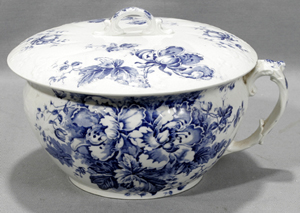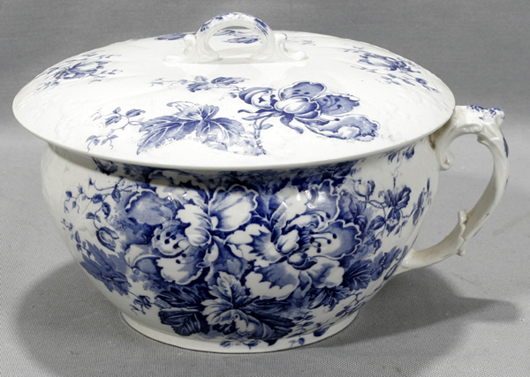
PARKERSBURG, W.Va. (AP) – A new exhibit in Parkersburg’s Blennerhassett Island Museum of Regional History promises to leave its viewers flushed with excitement.
Well, at least privy to the history of American privies.
“Behind Closed Doors – American Bathrooms Through the Ages,” opened earlier this month, and will remain on display through the end of this year. The exhibit features chamber pots, close stools, bedpans and early flush commodes and other indoor amenities used in households during the years before the arrival of indoor plumbing.
“We were looking for something different, something novel,” said Ray Swick, historian for Blennerhassett Island State Park, which operates the three-story museum in downtown Parkersburg.
“Interest in bathrooms is something that’s never gone out of style, yet you never see public exhibits dealing with them,” Swick said. “Thirty years ago, an exhibit like this might have been considered to be in poor taste. But people have loosened their corsets a little since then, and have a better attitude toward something that has always been a part of everyday life.”
Several pieces in the exhibit were already in the Blennerhassett Museum’s collection, but not singled out for co-starring roles in a showcase of historic potty items.
Among them is a close stool, or box-enclosed sit-on-top chamber pot used in the Parkersburg home of Arthur Ingram Boreman, West Virginia’s first governor.
Swick said the contents of the gubernatorial disposal device were deposited, presumably by a servant, “in the garden or into an outhouse” behind the Boreman home.
Boreman’s squat, spare close stool is dwarfed by a throne-like 18th century commode chair, which Swick picked up from an antique store in Natchez, Tenn.
“This piece had been used by a well-to-do family,” Swick said. “It’s very well made. You could close the lid on this chair and use it as an elegant piece of furniture.”
Other preplumbing waste control systems on display include chamber pots and bedpans of varying materials and functions, and an assortment of toddlers’ potty chairs.
Nonpotty accessories in the exhibit include a Victorian-era ceramic water pitcher and bowl perched atop a dresser stand from Parkersburg’s now-defunct Van Winkle Hotel, and a wooden bathtub with a zinc-copper liner equipped with wheels for room-to-room service.
Since rolled and perforated toilet paper didn’t arrive on the American scene until the 1880s, pages from telephone books, mail-order catalogs – even newspapers – were recycled and used for a second and final purpose, Swick said. “Now, the average American uses something like 70 miles of toilet paper a year,” he said.
The most up-to-date item in the exhibit is a 1920-vintage flush toilet with a wooden seat and holding tank.
While London plumber Thomas Crapper is widely credited with being the inventor of the flush toilet, back in the late 1800s, English inventor Sir John Harrington is the man truly responsible for its creation, according to Swick.
“Thomas Crapper improved upon the toilet invented by Harrington – he did not invent it himself,” Swick said.
Harrington, the godson of Queen Elizabeth I, invented a flushing lavatory in the 1590s, piping water from a rooftop cistern into a bowl equipped with a leather release valve at its base. A series of clamps, levers, weights and handles controlled the system, which Queen Elizabeth I reportedly tested, and approved of, during a visit to Harrington’s home in 1592.
Swick will present two lectures in conjunction with the exhibit. “A History of Bathrooms: From Ancient Times to the 21st Century,” will be presented at 1 p.m. on both April 20 and July 20, in the museum’s conference room.
“We’ve had a very encouraging response to the exhibit so far,” Swick said.
Also new at the Parkersburg museum is an exhibit on tobacco production and use in the Ohio Valley, which includes early cultivation and processing tools, a huge hogshead tobacco barrel made from a sycamore trunk and tobacco products and accessories used in the region, ranging from prehistoric stone pipes found on Blennerhassett Island to 20th century novelty lighters.
The Blennerhassett Museum, open year-round, offers exhibits covering life in the mid-Ohio Valley from prehistoric to modern times.
The entire lower level of the museum is devoted to prehistoric Native American tools, weapons, household items, toys, jewelry and ornaments collected by Professor Henry Stahl of Parkersburg during the late 1800s and early 1900s.
Other exhibits cover such topics as items associated with the Blennerhassetts and their idyllic island home; Gov. Boreman and his residence; 18th- and 19th-century tools and weapons, regionally produced glassware, and the history of Ohio River navigation and transportation.
___
If you go…
General admission to the museum, including a self-guided tour of the bathroom exhibit, is $4 for adults and $2 for children 3-12. Museum hours are 11 a.m. to 5 p.m. Tuesdays through Saturdays, and 1 to 5 p.m. on Sundays. For more information on the museum or Blennerhassett Island State Park, call 304-420-4800 or visit www.blennerhassettislandstatepark.com.
___
Information from: The Charleston Gazette, http://www.wvgazette.com
Copyright 2013 Associated Press. All rights reserved. This material may not be published, broadcast, rewritten, or redistributed.
AP-WF-02-15-13 1225GMT
ADDITIONAL IMAGE OF NOTE



